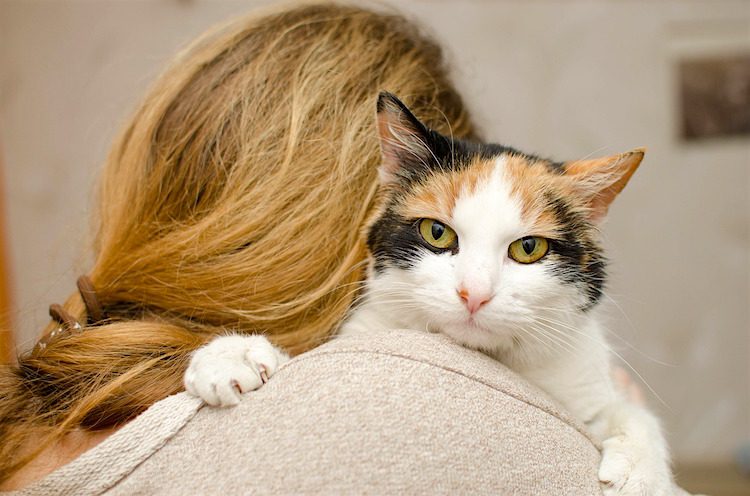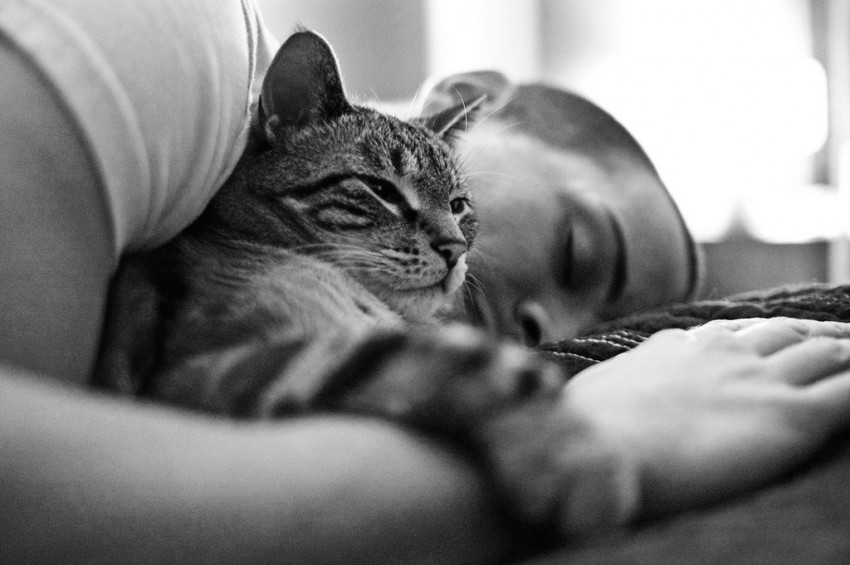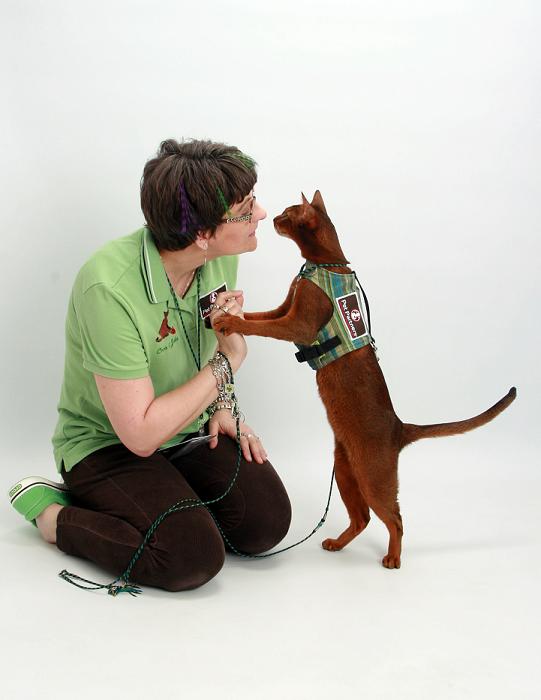
Lisa Davis found Princess, her now 17-year-old Maine Coon, at a local adoption event.
Davis had lost her previous cat a few months earlier. She knew she “wanted an adult cat who could wait for me to get home from work” — not a rambunctious kitten.
She and Princess clicked.
The cat was “really shy,” but that didn’t deter Davis, who was “very shy myself, so I understood her anxieties.”
Long story short, Princess ended up going home with her. “She has been a constant source of joy and comfort to me since then,” Davis says.
But there was more to it than that.
Cats as Emotional Support Animals
Davis suffered from anxiety and depression, and Princess made it possible for her to deal with both.
The Maine Coon who nobody else had wanted became an emotional support animal (ESA), complete with a letter from Davis’s doctor allowing the cat to “move into any apartment, including ones that do not allow animals.”
Those of us with pets already know how they can transform our lives — how just being with them can make the day’s tensions slip away.
So how do emotional support animals differ from those “regular” pets? Or from service animals or therapy animals?
The truth is, it’s easy to blur the borders.
But ESAs, according to Meowingtons, help “mitigate the negative symptoms of a person’s emotional or psychological disability by calming and reducing emotional distress.…
“An ESA can be any domesticated animal — cat, dog, rabbit, snake, pig, etc. — and must be prescribed by a licensed mental health professional (therapist, psychiatrist) and have a letter showing that they are part of the individual’s treatment plan.”

What’s the Difference?
Let’s discuss some of the differences between emotional support cats, therapy cats and service animals:
Emotional Support Animals
In the United States, emotional support animals like Princess have rights under the Air Carrier Act of 1986 and the Fair Housing Amendments Act of 1988 that pets don’t have.
Aside from the fact that no-pet housing clauses don’t apply to them, ESAs can fly for free with their humans.
As writer Mary Karmelek points out, this has led people to abuse the system, with many “who have no legitimate disabilities … claiming ESAs because they don’t want to leave their pets at home or pay for boarding.”
Was YOUR Pet Food Recalled?
Check Now: Blue Buffalo • Science Diet • Purina • Wellness • 4health • Canine Carry Outs • Friskies • Taste of the Wild • See 200+ more brands…

This abuse of the system has made things more difficult for those who do have those disabilities.
Davis, by the way, says she “would not travel with Princess or expect her to go on a plane” because she doesn’t want to “add any stress for her to deal with.”
“Emotional support is a two-way street for me,” she explains.
Service Animals
Service animals are dogs (and occasionally miniature horses) “specifically trained to do certain major life tasks for a person with physical or severe psychiatric disabilities,” according to Animal Planet’s Jane Harrell.
Unlike ESAs, service animals have to undergo extensive certification training. They are also registered.
Because of the work that service animals do, they have access to public places and businesses that other animals, even ESAs, don’t have.
Therapy Animals
Therapy animals are also trained and certified. They go into convalescent homes, hospitals, hospices, schools and disaster areas, and they work their magic.
In theory, any animal can become one, but initially dogs were the go-to therapy animals.
These days, more and more cats are coming into their own as furry therapists.
A couple of my friends are in the process of getting their cats — one of them a 3-legged rescue — trained to be therapy cats.

More and More Cats Are Becoming Therapy Animals
Let’s talk a little more about therapy cats, before we return to emotional support cats.
Here’s a quick story. When I met a woman named Bunny, she was in her early 80s and had a lovely condo in an assisted-living facility. Her only surviving child lived out of state.
That was OK, though, because she had Boofams, a former shelter cat who had been with her about 8 years.
The shy little cat provided Bunny with companionship and a focus for her days. They’d go out on the little patio with Boofams on a secure lead.
Then, sadly, the cat died after a brief illness.
Bunny missed her terribly. She was having more and more trouble with her eyes and heart, however, and felt it was probably wiser not to get another cat.
Bunny could have used visits from a therapy cat.
Therapy cats help all sorts of people. For elderly people like Bunny, they provide stimulation and non-threatening contact. They stimulate seniors’ mental faculties and help them recover more quickly from illnesses.
One study conducted in nursing homes in New York, Missouri and Texas showed that such therapy resulted in patients’ medication costs dropping an average of 69%.
Then there are children and teens with autism and other disorders. Cats seem to be able to unlock the person trapped within by sheer virtue of their quiet understanding.
For more on this, see “How Cats Have Helped My Son With Autism.”

What Makes a Good Therapy Cat?
Coco Koh has a therapy cat named Jake who was certified through Pet Partners (formerly the Delta Society).
Koh herself had to take a couple of 8-hour classes to learn “how to read your animal’s body language, how to behave around sick/elderly/mentally handicapped individuals and how to deal with situations like someone wanting to keep your animals.”
The instructors even touched on Health Insurance Portability and Accountability Act (HIPAA) laws.
According to Koh, cats should meet the following standards in order to be good therapy animals:
- Sociable and enjoy being around people
- Calm and not easily startled
- Unbothered by loud noises, yelling, dogs and other animals, and machinery and equipment
- Comfortable being in a strange environment
“Having the stroller helps a lot,” says Koh, “because it’s a piece of ‘home’ in the middle of a strange space.”
Making the Rounds
Koh and Jake started out visiting assisted-living facilities, but now they visit the long-term psychiatric wards at Tufts Medical Center and the Dr. Solomon Carter Fuller Center in Boston.
Jake takes pride in making the rounds, Koh says. “He’s never really gotten super-attached to any one patient, mainly because in the psych wards there’s a pretty high turnover. He is friendly to everyone, purring, head-butting and rubbing.”
This therapy cat is said to be “very patient and gentle” with patients who want to hold or hug him. He’ll even let them touch his ears or paws.
“He never reacts badly to that,” Koh says. “The most he’ll do is pull away or go back to his stroller.”
Here’s my take. I believe all cats have natural healing abilities — and some, like Jake, can take their gift on the road and spread the magic.
Watch the heartwarming story of Prana and her human:

Questions About Emotional Support Animals
Let’s go back to ESAs now. For many people, the jury’s still out on them.
“I think animals can reach lots of people outside of traditional models of treatments,” says Molly Crossman, a Yale University researcher.
Most of the research on ESAs currently focuses on dogs, Crossman says.
“We start with dogs, and I think a lot of other research groups do as well because it seems like dogs are … specially designed, for lack of a better word, to interact with people, to understand our social and emotional cues.”
That last part bothers me.
Cats and horses — and a number of other animals — are extremely sensitive to human “social and emotional cues.” And I think the research needs to be broadened to include these animals as well.
Final Thoughts on Cats as Emotional Support Animals
Yes, there are people gaming the ESA system.
But in my research on emotional support cats, I heard from people who were sincere about how their cats helped them cope.
“I think all our furbabies bring comfort into our lives by just living in the present and reminding us about what is really important,” says Lisa Davis.
Her emotional support cat, Princess, “is sitting next to me right now,” she says. And “just looking at her makes me feel calmer and more peaceful.”


